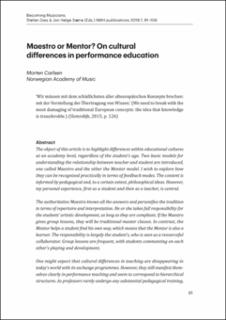| dc.description.abstract | Abstract -
The object of this article is to highlight differences within educational cultures at an academy level, regardless of the student’s age. Two basic models for understanding the relationship between teacher and student are introduced, one called Maestro and the other the Mentor model. I wish to explore how they can be recognised practically in terms of feedback modes. The content is informed by pedagogical and, to a certain extent, philosophical ideas. However, my personal experience, first as a student and then as a teacher, is central.
The authoritative Maestro knows all the answers and personifies the tradition in terms of repertoire and interpretation. He or she takes full responsibility for the students’ artistic development, as long as they are compliant. If the Maestro gives group lessons, they will be traditional master classes. In contrast, the Mentor helps a student find his own way, which means that the Mentor is also a learner. The responsibility is largely the student’s, who is seen as a resourceful collaborator. Group lessons are frequent, with students commenting on each other’s playing and development.
One might expect that cultural differences in teaching are disappearing in today’s world with its exchange programmes. However, they still manifest themselves clearly in performance teaching and seem to correspond to hierarchical structures. As professors rarely undergo any substantial pedagogical training, teaching methods are often not a result of conscious choice, they rather tend to preserve traditions that need challenging. In this respect, the relationship between interpretation and technique is a central factor, the question being if technique must be developed before interpretative skills become relevant or if they may be taught in parallel. The described models both have their strengths and weaknesses. It is important, however, to ask if authoritarian teaching still has a place in modern, democratic societies. | en_US |
